

The Florence Baptistry (a copyrighted image, thus gray scale and not clickable)Pisano's doors are at the doorway visible on the left. These bronze doors were commissioned by the Calimala, the guild responsible for the maintenance and decoration of the Baptistry, perhaps imagining a grand doorway, like those in Pisa or Venice. Prior to this, large scale casting had not been done in Florence. Little is known for certain about Andrea's background. It is clear he had been a goldsmith, but this is his first authenticated large work. (It is signed and dated at the top.) |
 |
|
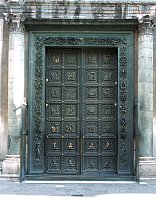
|
The South DoorsThe doors are comprised of two valves, each with 14 square panels. Twenty of the panels depict events from the life of John the Baptist while eight at the bottom are personifications of virtues. The twenty scenes relating to John the Baptist read chronologically from top to bottom and from left to right--on each valve. (That is, like pages of an open book, they read individually and not across "pages.") | |
The borders of the doors by Vittorio Ghiberti, son of Lorenzo (thanks to Jorge Odriozola for this information)One internet source says this: "The only surviving work known to be his [Vittorio Ghiberti's] is the decorative bronze frame of Andrea Pisano's South Portal doors for the Florence Baptistery, which he executed between 1453 and 1464. The sharp reliefs and floral details contrast somewhat incongruously with the Gothic austerity of Pisano's style, but it brought Vittorio considerable fame in his day." The borders of the reliefs have lozenge-shaped studs, rosettes, and lions at each of the corners (the marzocco, the symbol of Florence). Rows of dentils are just inside the frames. The external borders to the doors proper have figurative designs as well as foliate ribbons. |
||

|

|

|
| John the Baptist was the patron saint of baptistries as well as the patron saint of the city of Florence. The first six scenes depict the birth and youth of the Baptist while the next four show his public ministry, culminating in the baptism of Jesus. Like Giotto, Andrea Pisano depicts volumetric bodies with robes that help define the body (not conceal it). A kind of early realism is evident in the dynamic between some of his figures (see Herod and Salome below) and in the emotions and expressions of some of the figures. Contrast the naturalism of Pisano's portrayal with that of the mosaics on the lowest tier in the Baptistery. Although the scenes depicted are similar, Pisano's portrayal forecasts the Renaissance understanding and depiction of the body. | ||
Schema of the South Doors |
|||
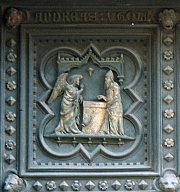
Angel announces to Zachariah |
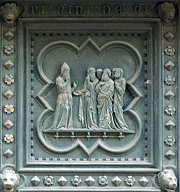
Zachariah is struck mute |
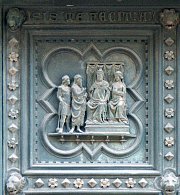
St. John reprimands Herod Antipas |

Incarceration of St. John |
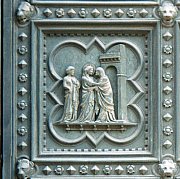
Visitation |

Birth of the Baptist |
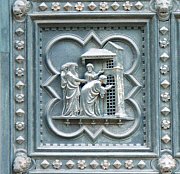
Disciples visit St. John |

Disciples visit Jesus |
| In the relief depicting John's disciples visiting him in prison, it is notable that John is not present. An important source for art about John the Baptist was an anonymous 14th century life of the Baptist. In it, in this scene John was inside the prison praying, which explains why he is absent. | |||
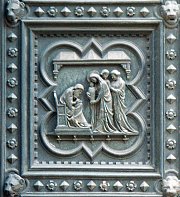
Zachariah writes the boy's name |
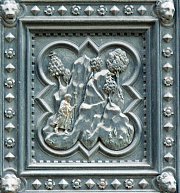
St. John as boy in desert |
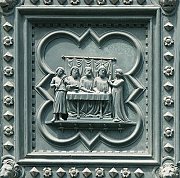
Dance of Salome |
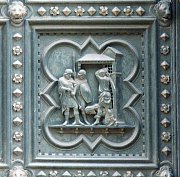
Decapitation of St. John |
| In the naming of the Baptist, the woman presenting the child is the Virgin Mary. (She has a halo.) In the Biblical version of the story she is not present. However, in the apocryphal tradition, she was present at his birth. Her presence signifies a special honor to the baby John. Note the rhythmic drapery folds in the garments of the figures. Salome has an identifiable coiffure as well as a distinctive headband (tiara?). | |||
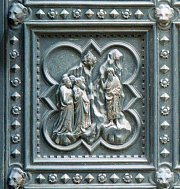
Preaching to the Pharisees |
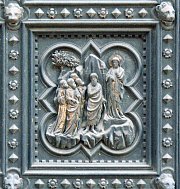
St. John announces Christ |
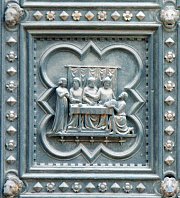
Presentation of St. John's head to Herod Antipas |
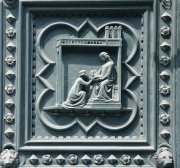
Salome takes head to Herodias |
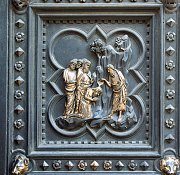
Baptism of his disciples |
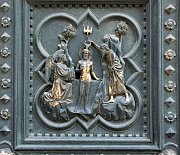
Baptism of Jesus |
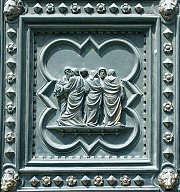
Transport of St. John's body |
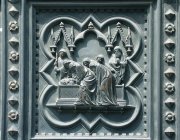
Burial of St. John |
| The baptism of Christ is depicted as so sacred that only an angel was present. The classical nude body of Christ demonstrates Pisano's mastery of anatomy. Note that in the death and burial of John the Baptist the same six disciples are present both carrying the corpse and placing the body in a sarcophagus. The head seems to be reattached in the transporting scene--perhaps out of a sense of decorum. An elaborate Gothic canopy is above the tomb of the Baptist. | |||
Personifications of virtues |
|||
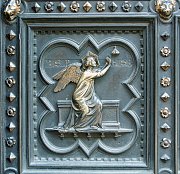
Hope |
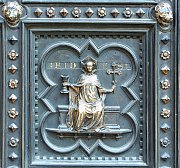
Faith |
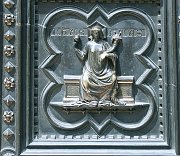
Charity |
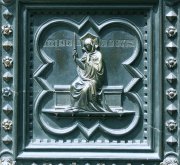
Humility |
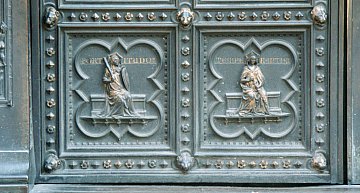
Fortitude and Temperance |

Justice and Prudence |
||
 Click here to return to index of art historical sites.
Click here to return to index of art historical sites.
 Click here to return to index of artists and architects.
Click here to return to index of artists and architects.
 Click here to return to chronological index.
Click here to return to chronological index.
